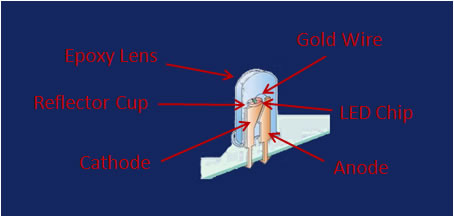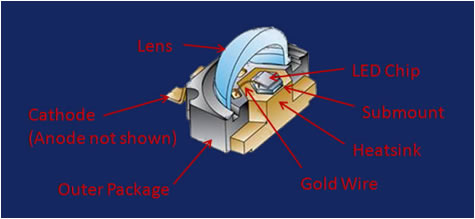What are LEDs? LED stands for Light Emitting Diode. It is a semiconductor device similar to diodes used in every day electronics, with the exception that when a current flows through an LED, light is created at the diode’s junction. There are two basic types of LEDs: conventional and high flux. Conventional LEDs are typically packaged in 3mm or 5mm packages and are used for indicator lights on everything from computers to appliances to automobiles. High Flux LEDs are used to provide high intensity light sources for traffic signals, flashlights, building lighting and other architectural lighting applications.


Conventional LED High Flux LED
Do LEDs get hot? Yes they do. A popular misconception is that LEDs are cool. In fact, although they are more efficient than many other light sources, LEDs waste about 80% of their input energy as heat. What makes LED light fixtures more of a design challenge is that this heat is created at the heart of the LED (in its P-N junction). Effectively removing that heat is what differentiates a well designed lighting fixture which will perform well over time. For this reason, many of the same techniques that are used to cool computer chips, such as heat sinks, are now being applied to LEDs.
Can LEDs run off AC power? Not directly. The voltage required to run an LED is typically between 3 and 4 volts DC (about the output of 2 household batteries). Furthermore, LEDs are polar devices which means that they only conduct current in one direction. In order to operate LEDs from AC power, a converter circuit, called a driver is required. This driver converts the high AC voltage to a lower DC voltage with a constant current. It should be noted that there are some “so-called” AC LEDs but these are basically LEDs configured as a rectifier to allow connection directly to the AC line. The other limitation for “AC LEDs” is that they only emit light when current is flowing in one direction, and therefore, only output 50% as much light.
How long will LEDs last? Unlike conventional incandescent bulbs which fail catastrophically after about 1000 hours, LEDs will typically last 30,000 to 50,000 hours or more with only a 30% reduction in light output. However, this lifetime is highly dependent on how hard the LEDs are driven as well as how well the heat is removed from the device. Additionally, the lifetime can also be affected by how the LEDs are handled during the assembly process as well as the environment under which they operate in the field. While LEDs normally just experience a reduction in light output as they age, it is possible for them to fail catastrophically if they are not used properly or are of poor quality.
What colors do LEDs come in? LEDs are offered in a number of colors from the various manufacturers. Typically they are offered in Royal Blue, Blue, Cyan, Green, Amber, Red-Orange, Red and White. In addition, there are ultraviolet and infrared LEDs for special applications. There are also multichip packages available with combinations of various single-color dice which can be used in combination to create a wide range of colors.
What are “cool” white LEDs? Most white LEDs are actually blue LEDs to which manufacturers add a yellow phosphor which, when combined with the blue light, produces a white appearing light output. In some cases manufacturers also add a second red phosphor to provide a light spectrum which more closely matches the output of an incandescent light or the light from the sun. These LEDs are usually referred to as “warm” white LEDs. Recently a third category of LEDs have been added known as “neutral” white. These LEDs typically fall between “cool” and “warm” spectra. Below for comparison are typical spectra of cool, neutral and warm white LEDs as well as the output from an incandescent source.

